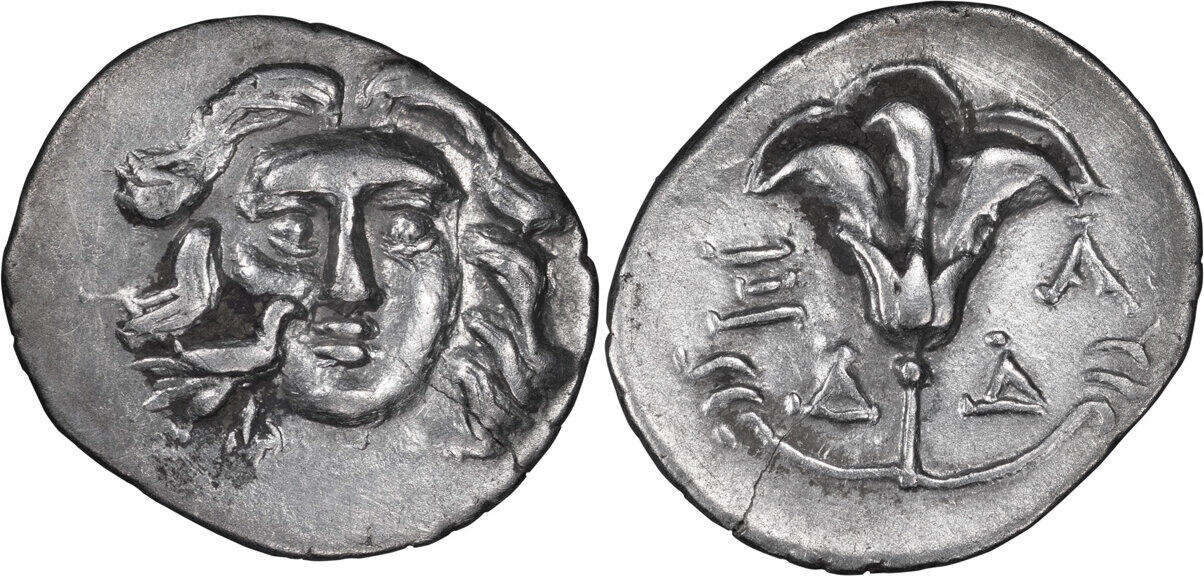Mylasa (Rhodian power), silver, drachms (Helios/rose) (180-150 BCE)
From SILVER
180 BCE - 150 BCE Silver 4,867 kg
Description
| ObverseInscription or printing placed on the obverse.: | Head of Helios with standing eagle on r. cheek |
| ReverseInscription or printing placed on the reverse.: | Rose on stem, with letters across upper field (abbreviation for month of March in the Macedonian calendar), and across lower field |
Mint and issuing power
| MintIdentifies the place of manufacture or issue of a numismatic object.: | Mylasa | Ancient regionAncient region.: | Caria | Modern countryModern country: Turkey | AuthorityIdentifies the issuing power. The authority can be "pretended" when the name or the portrait of X is on the coin but he/she was not the issuing power. It can also be "uncertain" when there is no mention of X on the coin but he/she was the issuing power according to the historical sources: | Rhodian power |
Chronology
| FromIdentifies the initial date in a range assigned in a numismatic context. | 180 BCE | toIdentifies the final date in a range assigned in a numismatic context.. | 150 BCE | PeriodTime period of the numismatic object.: Hellenistic 323-30 BC |
Physical description
| MetalThe physical material (usually metal) from which an object is made.: | Silver |
Median weightMedian of the weights of numismatic objects (in grams). in grams | 2.10 | DenominationTerm indicating the value of a numismatic object. Examples: tetradrachm, chalkous, denarius.: | drachma |
StandardStandard.: | Rhodian |
Image

H243 Mylasa rhodian drachms.jpg [1]
References
| Die study referencePublication of the study: | Ashton 19921Ashton 1992 | ||
| Coin series referenceReference to coin series study: | RQEMH2RQEMH, n° 243 | ||
| Coin series web referenceCoin series web references: | |||
Obverse dies distribution
| FrequencyFrequency of specimen in distribution. ᵖ | Number of obversesNumber of obverse dies. ᵖ (o) | % (o) | Number of coinsNumber of coins. (n) | % (n) | Die nameName(s) of the die(s). |
| 1 | 23 | 21.5 | 23 | 3.72 | 10, 13, 14, 15, 29, 39, 42, 44, 47, 59, 60, 68, 69, 72, 74, 78, 81, 89, 90, 92, 93, 97, 104 |
| 2 | 18 | 16.82 | 36 | 5.82 | 7, 8, 9, 16, 17, 21, 27, 33, 41, 43, 45, 46, 53, 61, 73, 82, 84, 99 |
| 3 | 12 | 11.21 | 36 | 5.82 | 12, 36, 37, 56, 63, 64, 65, 67, 70, 71, 75, 106 |
| 4 | 6 | 5.61 | 24 | 3.88 | 6, 80, 85, 88, 91, 94 |
| 5 | 13 | 12.15 | 65 | 10.5 | 22, 28, 32, 34, 35, 38, 40, 48, 66, 77, 79, 87, 107 |
| 6 | 7 | 6.54 | 42 | 6.79 | 3, 11, 18, 50, 57, 62, 83 |
| 7 | 5 | 4.67 | 35 | 5.65 | 1, 51, 58, 95, 96 |
| 8 | 2 | 1.87 | 16 | 2.58 | 49, 98 |
| 10 | 1 | 0.93 | 10 | 1.62 | 26 |
| 11 | 6 | 5.61 | 66 | 10.66 | 2, 4, 5, 100, 101, 105 |
| 12 | 2 | 1.87 | 24 | 3.88 | 54, 76 |
| 13 | 2 | 1.87 | 26 | 4.2 | 55, 86 |
| 14 | 1 | 0.93 | 14 | 2.26 | 102 |
| 15 | 1 | 0.93 | 15 | 2.42 | 30 |
| 16 | 3 | 2.8 | 48 | 7.75 | 25, 31, 52 |
| 17 | 1 | 0.93 | 17 | 2.75 | 23 |
| 24 | 1 | 0.93 | 24 | 3.88 | 103 |
| 30 | 1 | 0.93 | 30 | 4.85 | 24 |
| 32 | 1 | 0.93 | 32 | 5.17 | 19 |
| 36 | 1 | 0.93 | 36 | 5.82 | 20 |
| Total | 107 of 107 | 99.96 | 619 of 619 | 100.02 |
Reverse dies distribution
no distribution is available
Quantification
| Number of obversesNumber of obverse dies. ᵖ (o) | 107 | Number of singletons (o1)The number of singleton coins. ᵖ | 23 |
| Number of reverse diesNumber of reverse dies. (r) | 245 | Number of coinsNumber of coins. (n) | 619 |
| Coins per obverse dieNumber of coins per obverse die. (n/o) | 5.79 | Coins per reverse dieNumber of coins per reverse die. (n/r) | 2.53 |
| Reverse per obverse ratioRatio of obverse dies divided by reverse dies. (r/o) | 2.29 | Percentage of singletons (o1)number of coins (n) divided by the number of singletons (o1) ᵖ | 21.5 % |
| Original number of dies (O) (Carter 1983 formula)The estimation of the number of coins according to Carter 1983 ᵖ | 115.89 | Coins struck if 20,000 as average productivity per dieCoins made if the average productivity for obverses (according to Carter) is 20,000. ᵖ | 2,317,800 |
| Original number of dies (O) (Esty 2011 formula)The estimation of the number of coins according to the singleton formula in Esty 2011 ᵖ (O) | 129.36 | Survival rate if 20,000 as average productivity per dieSurvival rate if average productivity is 20,000. ᵖ | 0.00027 |
| Coverage (o = % of O) (Esty 1984 formula)Esty 1984 - coverage (% of O) ᵖ (o = % of O) | 96.28% | Die productivity if survival rate 1/2,000Average productivity if survival rate is 1/2,000. ᵖ | 10,682.54 |
| Weight of silver (in kg) if 20,000 coins per die (O = Carter formula)Carter 1983 * Median weight * 20000 (*10 if gold or electrum) ᵖ | 4,867 kg <br /> 4,867 kg | Die productivity if survival rate 1/5,000Average productivity if survival rate is 1/5,000. ᵖ | 26,706.36 |
Remarks